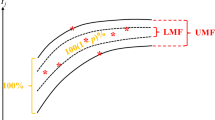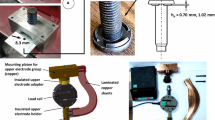Abstract
Precise and accurate prediction of future level of work in process (WIP) is an important task for factory control. To this end, a fuzzy linear regression (FLR)–partial consensus fuzzy intersection (PCFI)–radial basis function network (RBF) approach is proposed in this study. In the proposed methodology, a virtual expert committee is formed, instead of calling a number of experts in the field. For each virtual expert, a corresponding FLR equation is constructed to predict the level of WIP. Each FLR equation can be fitted by solving two equivalent nonlinear programming problems, based on the opinions of virtual experts. In order to aggregate these fuzzy WIP level forecasts, a two-step aggregation mechanism is used. First, PCFI is applied to aggregate the fuzzy forecasts into a polygon-shaped fuzzy number, in order to improve precision. Then, an RBF is constructed to defuzzify the polygon-shaped fuzzy number, and generate a representative/crisp value, resulting in improved accuracy. To evaluate the effectiveness of the proposed methodology, an actual case is discussed. According to the experimental results, the proposed methodology improved the precision and accuracy of the WIP level forecasting by 68% and 27%, respectively.
Similar content being viewed by others
References
Gue F (1980) Is work in process doing you in? Prod Eng 27(2):45–48
Buxton KV, Gatland R (1995) Simulating the effects of work-in-process on customer satisfaction in a manufacturing environment. Winter Simulation Conference Proceedings, pp. 940–944
Little JDC (1961) A proof of the queueing formula L = λW. Oper Res 9:383–387
Suzaki K (1985) Wok-in-process management: an illustrated guide to productivity improvement. Prod Invent Manag 26(3):101–110
Voorhees EM (1989) Work-in-process tracking system for experimental manufacturing. Proceedings of Second International Conference of Data Knowledge Systems and Manufacturing Engineering, pp. 190–197
Banta LE, Toh TS (1991) Work in process tracking using machine vision. Soc Mech Eng Dynam Syst Control Div 30:9–11
Cordon C (1995) Quality defaults and work-in-process inventory. Eur J Oper Res 80(2):240–251
Kuo CJ, Liu CM, Chi CY (2008) Standard WIP determination and WIP balance control with time constraints in semiconductor wafer fabrication. J Qual 15(6):409–423
Yang T, Fu H-P, Yang K-Y (2007) An evolutionary-simulation approach for the optimization of multi-constant work-in-process strategy—a case study. Int J Prod Econ 107(1):104–114
Lin YC, Chen T, Wu HC (2011) Future WIP level forecasting in a wafer fabrication factory with a hybrid fuzzy and neural approach. Int J Innov Comput Inf Control 7(8):4621–4634
Chen T, Lin YC (2008) A fuzzy-neural system incorporating unequally important expert opinions for semiconductor yield forecasting. Int J Uncertain Fuzziness Knowl-Based Syst 16(1):35–58
Chen T (2009) An online collaborative semiconductor yield forecasting system. Expert Syst Appl 36(3):5830–5843
Chen T (2009) A fuzzy-neural knowledge-based system for job completion time prediction and internal due date assignment in a wafer fabrication plant. Int J Syst Sci 40(8):889–902
Chen T, Wang YC (2011) A hybrid fuzzy and neural approach for forecasting the book-to-bill ratio in the semiconductor manufacturing industry. Int J Adv Manuf Technol 54(1–4):377–389
Chen T (2011) Applying a fuzzy and neural approach for forecasting the foreign exchange rate. Int J Fuzzy Syst Appl 1(1):36–48
Azadeh A, Nazari-Shirkouhi S, Hatami-Shirkouhi L, Ansarinejad A (2011) A unique fuzzy multi-criteria decision making: computer simulation approach for productive operators’ assignment in cellular manufacturing systems with uncertainty and vagueness. Int J Adv Manuf Technol 56(1–6):329–343
Chen T (2008) A fuzzy–neural approach for estimating the monthly output of a semiconductor manufacturing factory. Int J Adv Manuf Technol 39(5–6):589–598
Rodríguez-Guerrero L, López-Ortega O, Santos-Sánchez O (2012) Object-oriented optimal controller for a batch dryer system. Int J Adv Manuf Technol 58(1–4):293–307
Chen T (2011) Job cycle time estimation in a wafer fabrication factory with a bi-directional classifying fuzzy-neural approach. Int J Adv Manuf Technol 56(9):1007–1018
Yager RR (2011) On possibilistic and probabilistic information fusion. Int J Fuzzy Syst Appl 1(3):1–14
Chen T, Wang YC (2010) A bi-criteria nonlinear fluctuation smoothing rule incorporating the SOM-FBPN remaining cycle time estimator for scheduling a wafer fab—a simulation study. Int J Adv Manuf Technol 49(5):709–721
Chen T (2007) Incorporating fuzzy c-means and a back-propagation network ensemble to job completion time prediction in a semiconductor fabrication factory. Fuzzy Set Syst 158(19):2153–2168
Piramuthu S (1991) Theory and methodology—financial credit-risk evaluation with neural and neuralfuzzy systems. Eur J Oper Res 112:310–321
Chen T (2008) A SOM-FBPN-ensemble approach with error feedback to adjust classification for wafer-lot completion time prediction. Int J Adv Manuf Technol 37(7–8):782–792
Chen T (2006) A hybrid SOM-BPN approach to lot output time prediction in a wafer fab. Neural Proces Lett 24(3):271–288
Kurban T, Beşdok E (2009) A comparison of RBF neural network training algorithms for inertial sensor based terrain classification. Sensors 9:6312–6329
Chen T, Wang YC, Tsai HR (2009) Lot cycle time prediction in a ramping-up semiconductor manufacturing factory with a SOM-FBPN-ensemble approach with multiple buckets and partial normalization. Int J Adv Manuf Technol 42(11–12):1206–1216
Bárdossy A (1990) Note on fuzzy regression. Fuzzy Set Syst 65:65–75
Chen T, Jeang A, Wang YC (2008) A hybrid neural network and selective allowance approach for internal due date assignment in a wafer fabrication plant. Int J Adv Manuf Technol 36:570–581
Liu X (2007) Parameterized defuzzification with maximum entropy weighting function—another view of the weighting function expectation method. Math Comput Model 45:177–188
Hannan EJ, Rissanen J (1982) Recursive estimation of mixed autogressive-moving average order. Biometrika 69(1):81–94
Dickey DA, Fuller WA (1981) Likelihood ratio statistics for autoregressive time series with a unit. Econometrica 49(4):1057–1072
Author information
Authors and Affiliations
Corresponding author
Rights and permissions
About this article
Cite this article
Chen, T. The FLR–PCFI–RBF approach for accurate and precise WIP level forecasting. Int J Adv Manuf Technol 63, 1217–1226 (2012). https://doi.org/10.1007/s00170-012-3957-y
Received:
Accepted:
Published:
Issue Date:
DOI: https://doi.org/10.1007/s00170-012-3957-y




